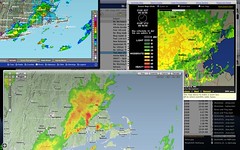With my wife and kids traveling this week, I had some extra time so I tried out Amazon
EC2 and
Mechanical Turk (next post).
EC2 is an incredibly "geeky" name for an amazing set of services that allow you to configure your own Unix or Windows computer in "the cloud" with some standard software like app servers and database for Linux/Windows.
I was able to setup a configuration with a login in just a few minutes. This is amazing to me -- as I have been on projects where this could take anywhere from 1 to 5 weeks! Granted some of the time was not actually work time but time to schedule for hardware procurement, ordering, delivery, setup, new electrical drops, personnel constraints etc. The difference is stunning - one person getting an instance up and running in minutes vs a month of realtime. And think about not having to explain why your project is more important than any other...
An "extra large" instance is 15 GB of memory, 8 EC2 Compute Units (4 virtual cores with 2 EC2 Compute Units each), 1690 GB of instance storage, 64-bit platform and would cost you between $0.8 and $1.2 per hour to run. And you only pay for what you use. Granted if you had to go to a large "instance" you would have a bit more work todo but it looks like the services Amazon provides handles this as well.
There seems to be decent
security* that probably is equivalent if not better than average enterprise.
Faster, Cheaper and perhaps equivalent security will definitely change the enterprise implementation business for the better. Allowing shorter implementations, more prototypes and better results at a lower cost.
Let me know what you think....
*Note that some people feel that "behind" their firewall is safer and perhaps in some cases that is actually true. However in many cases the perception of security is greater than the actual security. If you don't superglue your USB ports shut, remove CD drives from your laptop and don't require a token. (Aka the "something you have and something you know" rule) Then it would take someone about 10 minutes to change the root password of that laptop and another 5 to find all the passwords you have stored on your machine, in the browser cache or written on the case ....
 Image via Wikipedia
Image via Wikipedia Image by Suzie Katz via Flickr
Image by Suzie Katz via Flickr Continuing the "infovis" and Tyranny of Averages themes --
Continuing the "infovis" and Tyranny of Averages themes -- Image by bwc via Flickr
Image by bwc via Flickr![]() Image via CrunchBase
Image via CrunchBase